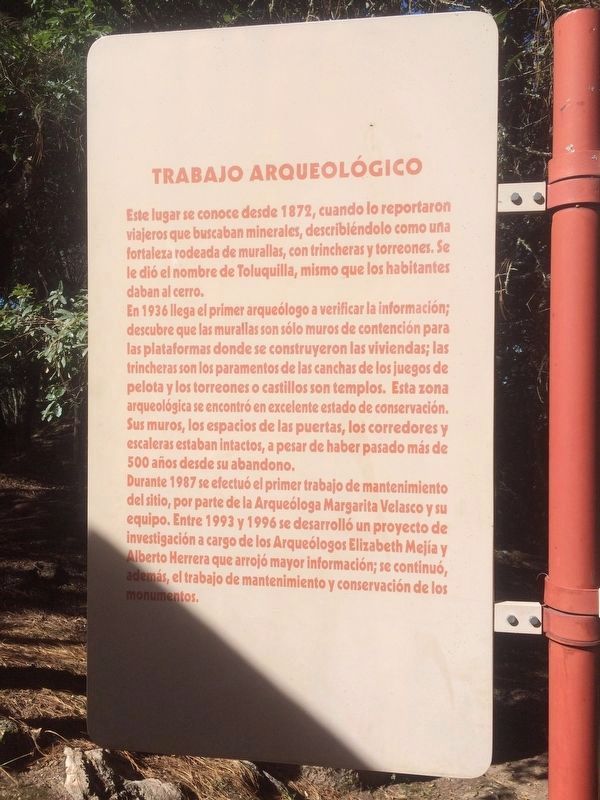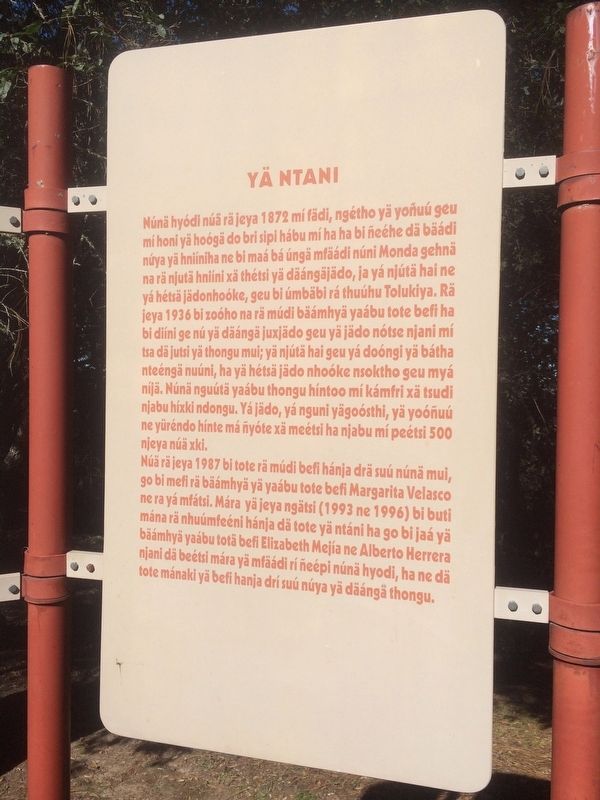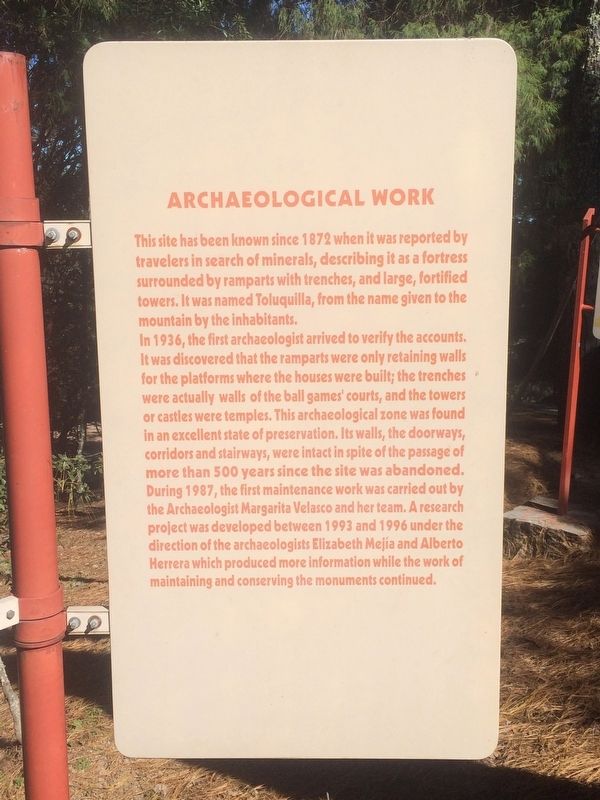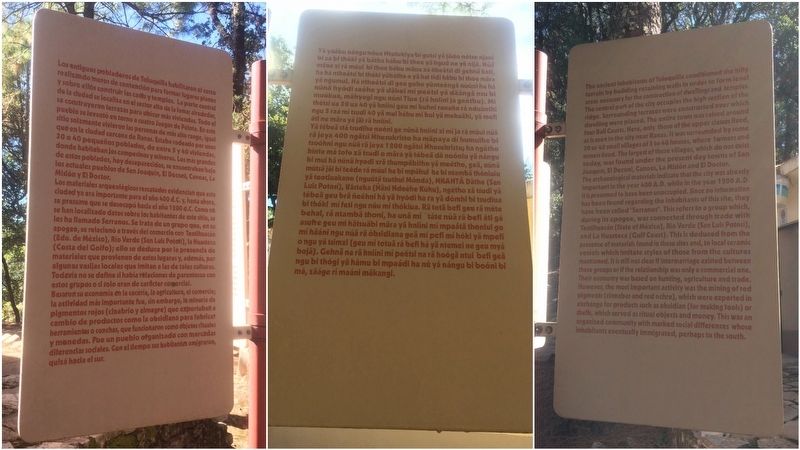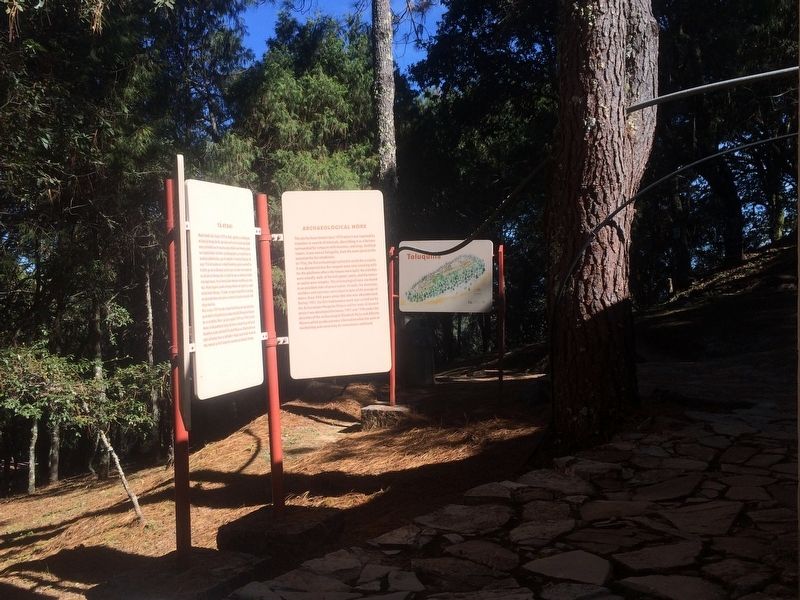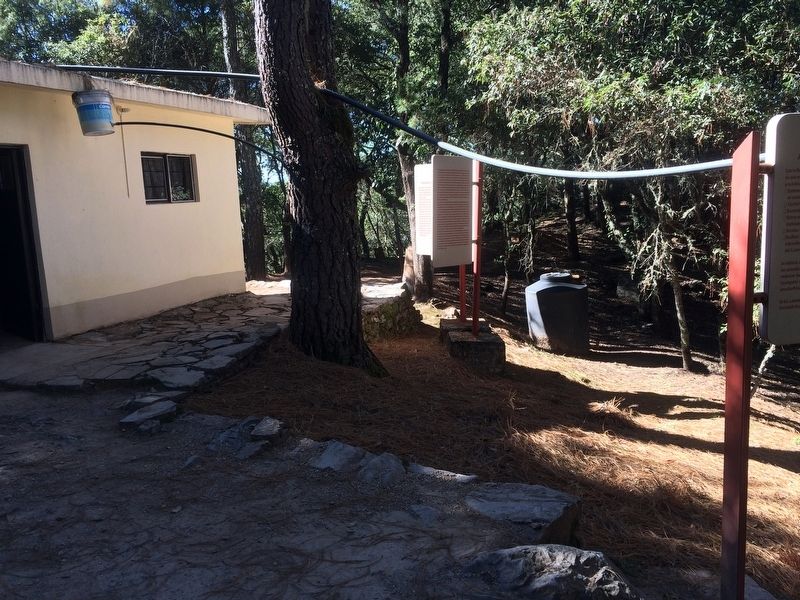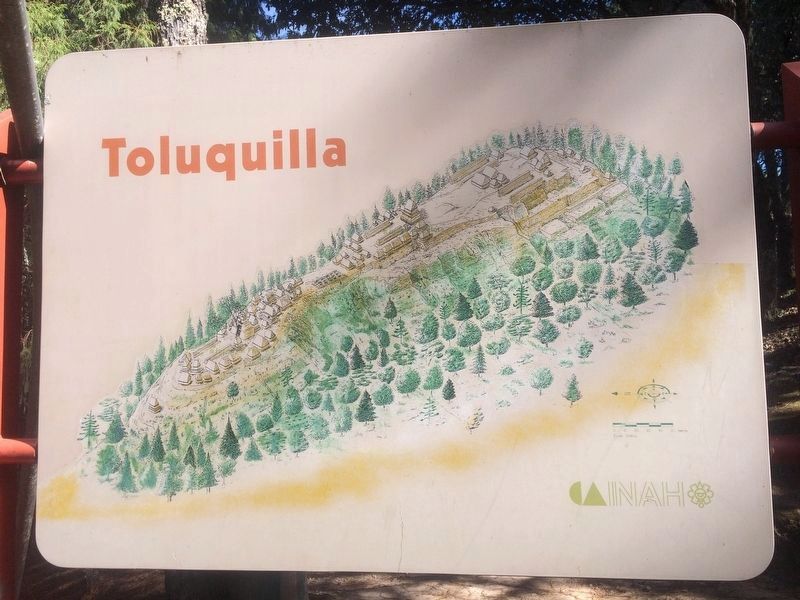San Joaquín in Cadereyta de Montes, Querétaro, Mexico — The Central Highlands (North America)
Archaeological Work at Toluquilla
Inscription.
Trabajo Arqueológico
Este lugar se conoce desde 1872, cuando lo reportaron viajeros que buscaban minerales, describiéndolo como una fortaleza rodeada de murallas, con trincheras y torreones. Se le dió el nombre de Toluquilla, mismo que los habitantes daban al cerro.
En 1936 llega el primer arqueólogo a verificar la información; descubre que las murallas son sólo muros de contención para las plataformas donde se construyeron las viviendas; las trincheras son los paramentos de las canchas de los juegos de pelota y los torreones o castillos son templos. Esta zona arqueológica se encontró en excelente estado de conservación. Sus muros, los espacios de las puertas, los corredores y escaleras estaban intactos, a pesar de haber pasado más de 500 años desde su abandono.
Durante 1987 se efectuó el primer trabajo de mantenimiento del sitio, por parte de la Arqueóloga Margarita Velasco y su equipo. Entre 1993 y 1996 se desarrolló un proyecto de investigación a cargo de los Arqueólogos Elizabeth Mejía y Alberto Herrera que arrojó mayor información; se continuó, además, el trabajo de mantenimiento y conservación de los monumentos.
Reversa:
Los antiguos pobladores de Toluquilla habilitaron el cerro realizando muros de contención para formar lugares planos y sobre ellos construir las casas y templos. La parte central de la ciudad se localiza en el sector alto de la loma; alrededor, se construyeron terrazas para ubicar más viviendas. Todo el pueblo se levantó en torno a cuatro Juegos de Pelota. En este sitio solamente vivieron las personas de más alto rango, igual que en la ciudad cercana de Ranas. Estaba rodeado por unos 30 o 40 pequeños poblados, de entre 5 y 40 viviendas, donde habitaban los campesinos y mineros. Los más grandes de estos poblados, hoy desaparecidos, se encontraban bajo los actuales pueblos de San Joaquín, El Deconi, Canoas, La Misión y El Doctor.
Los materiales arqueológicos rescatados evidencian que esta ciudad ya era importante para el año 400 d.С. y, hasta ahora, se presume que se desocupó hacia el año 1200 d.C. Como no se han localizado datos sobre los habitantes de este sitio, se les ha llamado Serranos. Se trata de un grupo que, en su apogeo, se relacionó a través del comercio con Teotihuacán (Edo. de México), Río Verde (San Luis Potosí), la Huasteca (Costa del Golfo); ello se deduce por la presencia de materiales que provienen de estos lugares y, además, por algunas vasijas locales que imitan a la de tales culturas. Todavía no
se define si había relaciones de parentesco con estos grupos o si solo eran de carácter comercial.
Basaron su economía en la cacería, la agricultura, el comercio; la actividad más importante fue, sin embargo, la minería de pigmentos rojos (cinabrio y almagre) que exportaban a cambio de productos como la obsidiana para fabricar herramientas o conchas, que funcionaron como objetos rituales y monedas. Fue un pueblo organizado con marcadas diferencias sociales. Con el tiempo sus habitantes emigraron, quizá hacia el sur.
Yä Ntani
Núnä hyódi núa rä jeya 1872 mí fädi, ngétho yä yoñuú geu mí honi yá hoóga do bri sipi hábu mí ha ha bi ñeéhe dä bäádi núya yä hniíniha ne bi maá bá úngä mfäadi núni Monda gehna na rá njutä hnini xi thétsi ya däángájädo, ja yá njútä hai ne yá heésá jädonhooke, geu bi úmbäbi rá thuúhu Tolukiya. Rä jeya 1936 bizoóho na ra múdi bäámhya yaábu tote befi ha nteéngä nuúni, ha yä hétsä jädo nhooke nsoktho geu myá níjä. Núnä nguútä yaábu thongu híntoo mí kámfri xä tsudi ne yüréndo hinte má nyóte xä meétsi ha njabu mí peétsi 500 njeya núa xki.
Núä räjeya 1987 bi tote rä múdi befi hánja drä suú núnä mui, go bi mefi rä bämhyä ya yaábu tote befi Margarita Velasco ne ra yá mfátsi. Mára yä jeya ngätsi (1993 ne 1996) bi buti mána rä nhuúmfeéni hánja dä tote yä ntáni ha go bijaá yä bäámhya yaábu totä befi Elizabeth Meijía ne Alberto Herrera njani dä beétsi mára yä mfäádi rí ñeépi núnä hyodi, ha ne dä tote manaki ya bef hanja dri suu nuya ya daanga thongu.
Reversa:
Yä yaábu nángu núua Ntolukiya bi gutsi yä jädo nótse njani bi za bi thóki yä bátha hábu bi thoe yähguu ne yä níjä. Núa mäna xi rá múui bi thoe hábu mäna xá nheétsi di gehnä kati, ha há ntheétsi bi thóki yübátha o ya hai tídi hábu bi thoe mära yä ngumul. Há ntheétsi di geu goho yünteéngä nuúni ha há muúkua, mähyegi ngu núni Tiue (rä hniíni ja geétbu). Mi thétsi ua 30 ua 40 yä hniíni geu mí buhni ranaño rá nduúnthi ngu 5 raá mí tsudi 40 yä mul hábu mí bui yä mehuähi, yä mefi áti ne mära yá jäi rä hniíni.
Yä tébeä stá tsudihe noóni ge núnä hniíni xi mí ja rá múui núä rä jeya 400 ngätsi Nhesukristo ha mäpaya di humuihe bi tsoóhni ngu núä rä jeya 1200 ngätsi Nhesukristoj ha ngétho hinte má tofo xä tsudi o mära yä tébeä dä noóniu yä nángu bi mui há nún hyodi xrä thumpäbitho yä meétho, gea, núnä mútsä jäi bi teéde rá múui ha bi mpähuí ha bi ntambä thóniuiu yä teotiuakano (nguútä tsuthui Mónda), Nkanta Däthe (San Luis Potosí), Uásteka (Näni Ndeéhe Kúhu), ngétho xä tsudi yä tébeä geu bräneéhni há yä hyódi ha ra yä dómhi bi tsudiua bi thóki mí feti ngu núu mí thókiua. Rä totä befi geu rä méte behal, rä ntambä thoni, ha una mí 'táte núä rä befi áti gá asufre geu mí hätsuäbi mära yä hniíni mí mpaátä thoniul go mí häáni ngu núa ră óbsidiana geä mí pefi mí hóki yä mpefi o ngu yä tsimxi (geu mí totuä rá befi há yä ntemei ne geu myá bojä). Gehna na rä hniíni mí peétsi na rä hoógä ntui befi geä ngu bi thógi yä hámu bi mpaádi ha nú yá nángu bi boóni bi má, zäáge rí maáni mäkangi.
Archaeological Work
This site has been known since 1872 when it was reported by travelers in search of minerals, describing it as a fortress surrounded by ramparts with trenches, and large, fortified towers. It was named Toluquilla, from the name given to the mountain by the inhabitants.
In 1936, the first archaeologist arrived to verify the accounts. It was discovered that the ramparts were only retaining walls for the platforms where the houses were built; the trenches were actually walls of the ball games’ courts, and the towers or castles were temples. This archaeological zone was found in an excellent state of preservation. Its walls, the doorways, corridors and stairways, were intact in spite of the passage of more than 500 years since the site was abandoned. During 1987, the first maintenance work was carried out by the Archaeologist Margarita Velasco and her team. A research project was developed between 1993 and 1996 under the direction of the archaeologists Elizabeth Mejía and Alberto Herrera which produced more information while the work of maintaining and conserving the monuments continued.
Reverse:
The ancient inhabitants of Toluquilla conditioned the hilly terrain by building retaining walls in order to form level areas necessary for the construction of dwellings and temples. The central part of the city occupies the high section of the ridge. Sorrounding terraces were constructed over which dwelling were placed. The entire town was raised around four Ball Courts. Here, only those of the upper classes lived, as is seen in the city near Ranas. It was surrounded by some 30 or 40 small villages of 5 to 40 houses, where farmers and miners lived. The largest of these villages, which do not exist today, was found under the present day towns of San Joaquin, El Deconi, Canoas, La Misión and El Doctor.
The archaeological materials indicate that the city was already important in the year 400 A.D. while in the year 1200 A.D it is presumed to have been unoccupied. Since no information has been found regarding the inhabitants of this site, they have been called "Serranos". This refers to a group which, during its apogee, was connected through trade with Teotihuacán (State of México), Río Verde (San Luis Potosí), and La Huasteca (Gulf Coast). This is deduced from the presence of materials found in these sites and, to local ceramic vessels which imitate styles of those from the cultures mentioned. It is still not
clear if intermarriage existed between these groups or if the relationship was only a commercial one. Their economy was based on hunting, agriculture and trade. However, the most important activity was the mining of red pigments (cinnabar and red ochre), which were exported in exchange for products such as obsidian (for making tools) or shells, which served as ritual objects and money. This was an organized community with marked social differences whose inhabitants eventually immigrated, perhaps to the south.
Erected by Instituto Nacional de Antropología e Historia (INAH).
Topics. This historical marker is listed in these topic lists: Anthropology & Archaeology • Architecture • Man-Made Features • Native Americans. A significant historical year for this entry is 1872.
Location. 20° 53.072′ N, 99° 31.882′ W. Marker is in San Joaquín, Querétaro, in Cadereyta de Montes. Marker can be reached from Unnamed road just west of Carretera San Joaquín-Querétaro. The marker is at Toluquilla Archaeological Site, turning on to an unnamed road some few kilometers from the town of San Joaquín on Route 120 towards Querétaro. This marker is just near the small visitors center at the site. Touch for map. Marker is in this post office area: San Joaquín QUE 76529, Mexico. Touch for directions.
Other nearby markers. At least 8 other markers are within 5 kilometers of this marker, measured as the crow flies. The History and Natural Environment of Toluquilla
(within shouting distance of this marker); Ball Court One (within shouting distance of this marker); Place of the Magueyes (about 180 meters away, measured in a direct line); Ball Court Two (approx. 0.2 kilometers away); Observation Post "La Crucita" (approx. 4.6 kilometers away); Historic Tree (approx. 4.6 kilometers away); Monument to the Miner (approx. 4.8 kilometers away); The Round Stone Monument (approx. 4.8 kilometers away). Touch for a list and map of all markers in San Joaquín.
Credits. This page was last revised on February 1, 2018. It was originally submitted on February 1, 2018, by J. Makali Bruton of Accra, Ghana. This page has been viewed 132 times since then and 8 times this year. Photos: 1, 2, 3, 4, 5, 6, 7. submitted on February 1, 2018, by J. Makali Bruton of Accra, Ghana.
